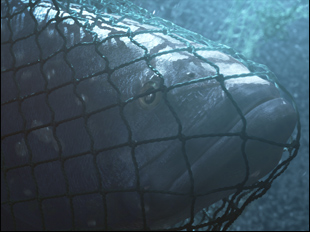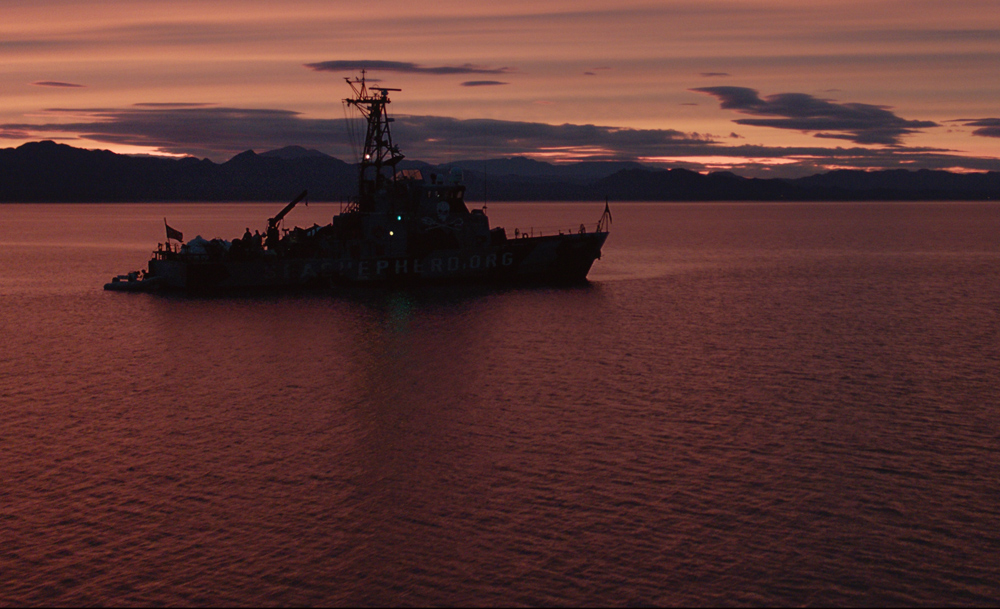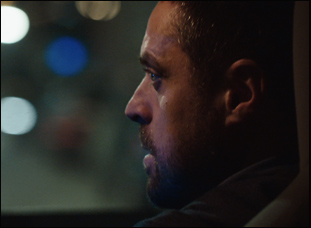Early on in “Sea of Shadows,” the marine veterinarian Dr. Cynthia Smith mentions that there is no known underwater footage of the vaquita, a porpoise that swims in the Sea of Cortez just off the Gulf of California. The species has steadily dwindled down to less than 15 since the introduction of fishing nets into the ocean, aimed at catching totoaba, a fish that’s prized not for its beauty or its meat, but for its swim bladder, which is believed by the Chinese to have special spiritual powers and can easily claim thousands of dollars on the black market. This meant that filmmaker Richard Ladkani didn’t even know what he was looking for when he began filming his follow-up to “The Ivory Game,” able to rely only on the description from those who he was following in the efforts to save the vaquita from extinction and the limited photos of vaquitas that have washed ashore, well past the point of recognition.
“All we had was photographs of dead, decomposed vaquita, so that’s not going to work for an emotional connection,” says Ladkani about the unique challenge he faced in “Sea of Shadows,” not only having to locate a vaquita without a proper reference, but then to understand it as a living creature. “So to actually capture the footage of one and actually see it up close and experience it from two feet away, just having this moment was very important for us as filmmakers and it’s very important for the audience to connect to this animal and to understand what we’re about to lose forever if there’s no action.”
Ladkani has ensured that if the vaquita go extinct, there will at least be a historical record of the beautiful dolphins distinguished by the ring around their eyes with “Sea of Shadows,” but he has done everything within his considerable power as a filmmaker to ensure that doesn’t happen as one can understand from the mere minutes of footage of a living, breathing vaquita why it has galvanized so many to save it, from the Sea Shepherd Conservation Society that patrols the waters for bad actors to local fishermen who understand the entire ecology of the ocean and attempt to prevent others from taking the short-term payday of catching totoaba with illegal nets that will ultimately destroy future sustainability. These efforts have been aided on land by Andrea Crosta, the founder of Earth League International whom Ladkani and co-director Kief Davidson first encountered in “The Ivory Game,” as he uncovered the supply chain driving the poaching of elephants for their tusks and has built a network of operatives around the world tracking illegal trade dependent upon the slaughter of animals.
While Ladkani inevitably tugs at the heart when observing the needless deaths that occur as a result of the totoaba being sold off for parts, “Sea of Shadows” takes the form of a fascinating cerebral thriller as it works to pull all of the pieces together from the rescue of what vaquita remain to creating attention for their plight through the intrepid journalist Carlos Loret de Mola with a platform on national TV, all the while evading gunfire from Mexican cartels that serve as the start for an international pipeline for the totoaba bladders that reaches around the world. The gripping particulars of such a story could only be conveyed cinematically, and with the patience afforded by the environmentally conscientious producing team that includes Leonardo DiCaprio’s Appian Way and Terra Mater Studios, the film represents a remarkably risky endeavor lays out a dire situation so plainly affecting as to be undeniable. With the film coming out in theaters following a debut at Sundance earlier this year where it won the Audience Award for Best Documentary in World Cinema, Ladkani and Crosta spoke about the origins of “Sea of Shadows” and making a film that will move audiences to action after learning all that’s at stake.
Richard Ladkani: We had just finished “The Ivory Game” and then Andrea first told me about the totoaba trade and the extinction of the vaquita very shortly after. To be honest, I didn’t respond very much to it because I thought, “Okay, there is an issue in Mexico about two animals I’ve never heard of and I can’t even pronounce. By the time I get this film a commercial audience and a lot of attention, it’s very hard.” So I was keeping low, but he kept pushing and he said, “Look, this is bigger than the two species. This is about an ecosystem that is dying because it’s being attacked by cartels and the Chinese mafia.” That got my attention and very soon after, it was a great coincidence that Leonardo DiCaprio, [who] was a champion of the vaquita pushing for the Vaquita CPR project that’s featured in the film, the safe extraction of the vaquita into a safety zone, actually called us and said, “Look, would you be interested in doing a film on this issue. I would executive produce and I will open doors. You’d have exclusive access to the whole rescue operation. I can introduce you to some people in Mexico like Carlos Loret de Mora.” This changed everything. From that moment on, Terra Mater was totally behind it and said they would fund the film and within 24 hours, we launched the film and then went straight into production because it was eight weeks before the actual operation started. So from zero to full on, it was like within a day.
How much of an idea do you have about the supply chain before filming?
Richard Ladkani: When we went into this film, I wasn’t sure it was going to be a very wildlife-related film and I didn’t know how big the story was around it, but very soon we realized that as the operation took a very sharp and dramatic turn, and suddenly the cartel started to take over, it starts to [turn] from a wildlife story to a real crime story and it got incredibly dangerous for all of us. But that’s when I realized, we have to keep shooting. We have to tell the full story now and we will have to take huge risks to tell the story because we’re not going to be effective [otherwise], so we needed to get corruption on tape. We needed to get evidence that [there’s] really smuggling [the totaoba swim bladder] on a large scale, so we needed to make sure we get all those points and then it became a wildlife crime thriller. That wasn’t clear for us when we went in. We had no idea what kind of film this was going to be.
Andrea’s operations at Earth League International had been involved already for a year so when we came on, they had completed an investigation in China and also had done an operation in Mexico. They were pretty much dead on in terms of understanding how the syndicate operates, but once we came on, it was all a matter of how can we follow your operation from here on forward, going deeper and understanding how the cartel operates. It was all about staying invisible, not interfering with Andrea’s work, his team’s work and somehow being there when it happened as it happened on standby. That’s why a film like that costs a lot of money and that’s why we need good resources and obviously our great relationship, [which] helped a lot in being there when it mattered and when we had to be there to follow the investigations.

Richard Ladkani: There’s very few organizations in the world that do the kind of work Earth League International is doing, really a handful, and it’s so amazing for us to have access to an organization like that because they fight for the planet earth and they use methods that the FBI and the CIA use. To be able to be embedded with people like that is a unique experience and a privilege, so it’s so important to work together and for me to have this access because we can really show the world this side of fighting wildlife crime. Having this hands on experience is a great thing for people to see and I think it inspires them as well. These are our new heroes that the world needs to know about.
To that end, since “The Ivory Game,” the organization has been rebranded from Elephant Action League to Earth League International. Andrea, did the making of that film or the response to it influence the decision to expand the mission?
Andrea Crosta: Yes, certainly. Since the beginning, the idea was to be as innovative as possible in our approach. That’s why we, for example, established WildLeaks five years ago, which is the first whistleblowing initiative for environmental crime [because] we really saw the need to change the approach to fighting it. So when we decided to change our name to Earth League International, we were actually already doing a lot more than elephants — we’d been working a lot on rhino horn trafficking and jaguar trafficking from Latin America, so basically we are applying our skills and our methodology and our experience of our incredible team — former FBI and former intelligence officers — to a variety of other environmental crime-related issues. So the name change was just the very end of this process of [becoming a] small intelligence agency for the planet and we’re really interested in not just keep working, but also advancing the need to create one or more intelligence agency for the planet if we really want to fight back.

Richard Ladkani: Yeah, very much. When you do a film on a very tough issue and you also talk about species that nobody has heard about and a situation in a place that is quite remote – not really everyone knows where the Sea of Cortez is — what you need is an approach that will appeal to large audiences because otherwise it will not get you a general audience and without a general audience, what are you doing for the cause? Nobody’s going to be emotionally connected if you don’t make it work for the audience, so we choose a more entertainment approach. We want people to feel like they’re watching a thriller because it was a thriller [actually filming it]. Honestly, this was the most dangerous film I’ve ever done and it felt every day we were threatened by the cartel or the Chinese mafia. It was the first time we needed bodyguards to sleep normally at night and we had protection around the clock, people on the roofs looking out. It was a very, very intense operation for all of us and I wanted that to come across.
But I don’t want to make a film that is hard to watch or difficult, and I always say there’s a lot of hope in this film because I think people are sometimes afraid to watch a film like that because they think it’s going to be all dark and gloomy. A lot of people wonder, “Well, isn’t it too late? You’re fighting for these last 15 animals and it’s over, isn’t it?” And I always say, “No, it’s not” because there’s actually scientific data now that they analyze the vaquitas very thoroughly and they say they can come back from even very low numbers, so there actually is real hope that if they’re just left alone and if we can stop the nets from going in that kill everything in its path, the vaquitas can come back and repopulate. That would be such an amazing success story, and [if you just look] at Jack from Sea Shepherd – he’s 22 years old. On the ship, they’re like 23 and 24-year-olds who are fighting for our planet. The young people are rising up and I try to focus on the positive things and present people who are extremely inspirational, the people who give us the power to fight on, because we will be the ones to turn it around. We won’t stop until we save this place – not just the vaquita, but the whole Sea of Cortez and help these local fishermen have a future.

“Sea of Shadows” opens on July 12th in Los Angeles at the Landmark and the Arclight Hollywood and in New York at the Landmark at 57 West and the Quad Cinema. A full schedule of cities and dates is here.





